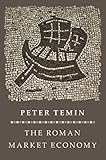The Roman Market Economy / Peter Temin.
Material type: TextSeries: The Princeton Economic History of the Western World ; 44Publisher: Princeton, NJ : Princeton University Press, [2012]Copyright date: ©2012Edition: Core TextbookDescription: 1 online resource : 16 line illus. 16 tablesContent type:
TextSeries: The Princeton Economic History of the Western World ; 44Publisher: Princeton, NJ : Princeton University Press, [2012]Copyright date: ©2012Edition: Core TextbookDescription: 1 online resource : 16 line illus. 16 tablesContent type: - 9780691147680
- 9781400845422
- 330.937 23
- HC39 .T46 2017
- online - DeGruyter
- Issued also in print.
| Item type | Current library | Call number | URL | Status | Notes | Barcode | |
|---|---|---|---|---|---|---|---|
 eBook
eBook
|
Biblioteca "Angelicum" Pont. Univ. S.Tommaso d'Aquino Nuvola online | online - DeGruyter (Browse shelf(Opens below)) | Online access | Not for loan (Accesso limitato) | Accesso per gli utenti autorizzati / Access for authorized users | (dgr)9781400845422 |
Frontmatter -- Contents -- Preface and Acknowledgments -- 1. Economics and Ancient History -- Part I: Prices -- Introduction: Data and Hypothesis Tests -- 2. Wheat Prices and Trade in the Early Roman Empire -- 3. Price Behavior in Hellenistic Babylon -- Appendix to Chapter 3 -- 4. Price Behavior in the Roman Empire -- Part II: Markets in the Roman Empire -- Introduction: Roman Microeconomics -- 5. The Grain Trade -- 6. The Labor Market -- 7. Land Ownership -- 8. Financial Intermediation -- Part III: The Roman Economy -- Introduction: Roman Macroeconomics -- 9. Growth Theory for Ancient Economies -- 10. Economic Growth in a Malthusian Empire -- Appendix to Chapter 10 -- 11. Per Capita GDP in the Early Roman Empire -- References -- Index -- Backmatter
restricted access online access with authorization star
http://purl.org/coar/access_right/c_16ec
The quality of life for ordinary Roman citizens at the height of the Roman Empire probably was better than that of any other large group of people living before the Industrial Revolution. The Roman Market Economy uses the tools of modern economics to show how trade, markets, and the Pax Romana were critical to ancient Rome's prosperity. Peter Temin, one of the world's foremost economic historians, argues that markets dominated the Roman economy. He traces how the Pax Romana encouraged trade around the Mediterranean, and how Roman law promoted commerce and banking. Temin shows that a reasonably vibrant market for wheat extended throughout the empire, and suggests that the Antonine Plague may have been responsible for turning the stable prices of the early empire into the persistent inflation of the late. He vividly describes how various markets operated in Roman times, from commodities and slaves to the buying and selling of land. Applying modern methods for evaluating economic growth to data culled from historical sources, Temin argues that Roman Italy in the second century was as prosperous as the Dutch Republic in its golden age of the seventeenth century. The Roman Market Economy reveals how economics can help us understand how the Roman Empire could have ruled seventy million people and endured for centuries.
Issued also in print.
Mode of access: Internet via World Wide Web.
In English.
Description based on online resource; title from PDF title page (publisher's Web site, viewed 08. Jul 2019)


